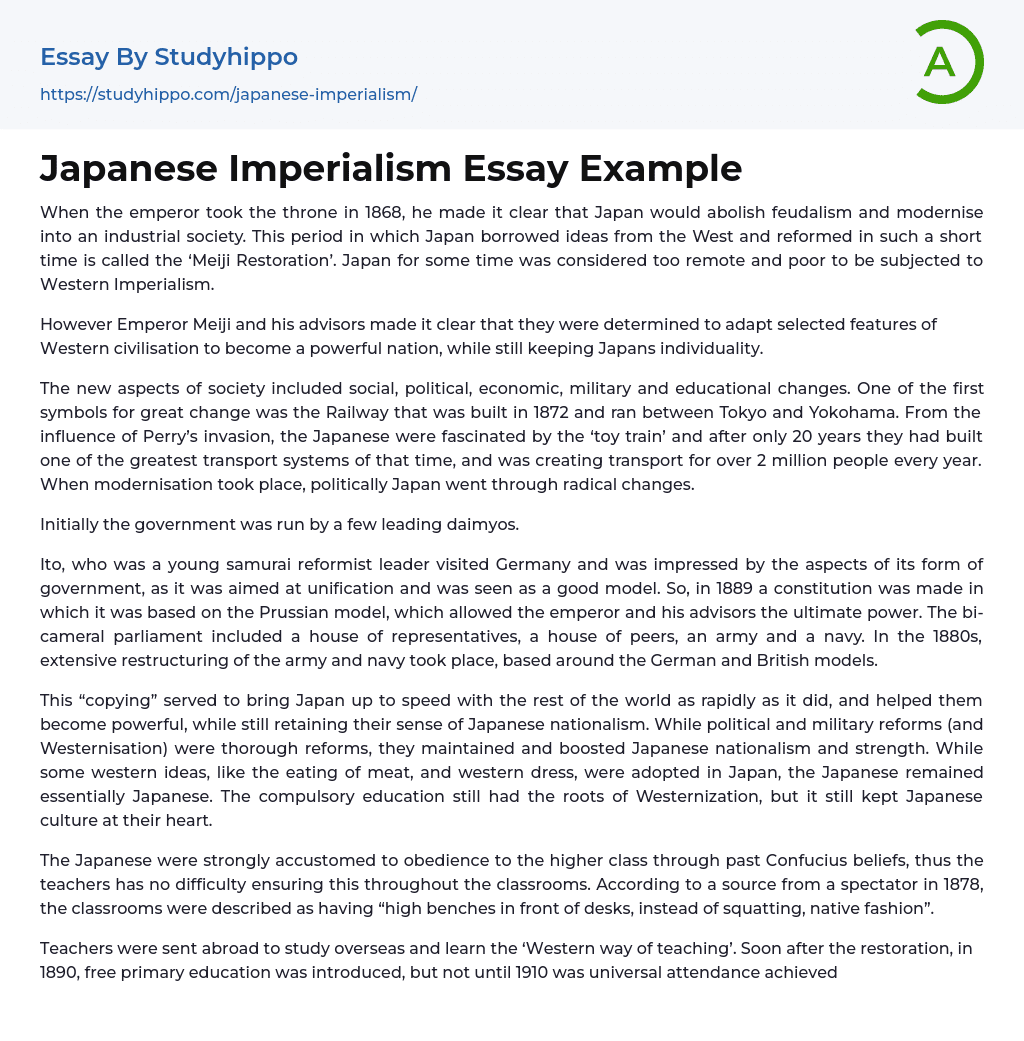Upon ascending the throne in 1868, Emperor Meiji announced the ‘Meiji Restoration’, a period when Japan aimed to modernize and eliminate feudalism to transform into an industrial society. Despite being considered remote and impoverished initially, Meiji and his advisors were determined to preserve Japan's identity while adopting selected Western features. The resulting societal changes encompassed social, political, economic, military, and educational spheres. In 1872, Japan constructed its railway system connecting Tokyo and Yokohama which carried more than two million passengers annually within two decades of Commodore Perry's invasion. Politically, Japan underwent immense transformations by moving away from government control by a few daimyos. Young samurai reformist leader Ito visited Germany where he was impressed with its unifying form of government as a good model back in 1889 when the constitution formed in Japan took after the Prussian style that granted ulti
...mate power to the emperor and advisors. The parliament had representatives' houses alongside peers', plus an army and navy underwent extensive restructuring similar to German or British models. Through mimicking Westernization within political, military, and educational reforms while preserving Japanese nationalism helped Japan catch up with the world rapidly.Japan adopted some Western practices such as clothing and consumption of meat, but it maintained its native culture at the center of compulsory education. Japan's cultural beliefs ingrained obedience to higher classes due to past Confucian influences. In 1878, high benches replaced squatting in classrooms after teachers were sent abroad to learn western teaching styles. Japan introduced free primary education following its restoration in 1890, achieving universal attendance in 1910. This reform led to higher literacy rates among younger generations, promoting modernization and egalitarianism while enforcing nationalism.
Westernization had a comprehensive economic impact on Japan, transforming it from a poor agriculture-based country ruled by feudal lords into an industrialized, urbanized modern nation with a unified monetary system using the yen introduced in 1871. As western ideas permeated society during the Meiji period, literature flourished producing influential writers like Natsume Soseki and Mori Ogai. The Tokyo art school was founded in 1876 under government encouragement for promotion of Western painting ideals.During the Meiji period, Japanese architects who had trained overseas began constructing Western-style buildings in Japan alongside a cultural evolution. The Bank of Japan and Tokyo Central station became iconic structures during this time. The popularity of western style music led to its integration into the school curriculum, with an emphasis on marches, harmonies, and opera. The emperor's public appearance in Western clothing served as encouragement for the adoption of Western ideas. By 1872, all court and official ceremonies required Western dress which later became standard formal attire. Traditional samurai top knots were replaced with western haircuts and material items such as black rolled umbrellas, gold watches, fitted tables and chairs, western calendars, and telegraphs were all introduced. Eating habits shifted with popular items like meat, bananas, beer, bread and dairy products encouraged by the emperor himself. Between 1868-1890 significant changes took place in Japan where "civilization and enlightenment" became a popular slogan driving fascination to adopt a Western approach that encompassed reforms of the military economy political system education social issues.
A school child succinctly summed up these changes stating: "If we hadn't opened the country up we'd still just be eating rice all the time."
Japan quickly gained significant power comparable to
that of Western nations in less than 50 years due to these changes. It was commonly believed that embracing all aspects of western culture, including science, technology and other areas, was necessary to be recognized as equals. Despite undergoing this significant transformation, Japan maintained its unique national identity.
- Academia essays
- Higher Education essays
- Language Learning essays
- Studying Business essays
- Education System essays
- Study essays
- First Day of School essays
- Scholarship essays
- Pedagogy essays
- Curriculum essays
- Coursework essays
- Studying Abroad essays
- Philosophy of Education essays
- Purpose of Education essays
- Brainstorming essays
- Educational Goals essays
- Importance Of College Education essays
- Brown V Board of Education essays
- The Importance Of Higher Education essays
- Online Education Vs Traditional Education essays
- Academic And Career Goals essays
- Academic Integrity essays
- Brown Vs Board Of Education essays
- Distance learning essays
- Technology in Education essays
- Vocabulary essays
- Writing Experience essays
- Importance of Education essays
- Early Childhood Education essays
- Academic Degree essays
- Academic Dishonesty essays
- School Uniform essays
- Academic writing essays
- Cheating essays
- Bachelor's Degree essays
- MBA essays
- College Life essays
- Grade essays
- Diploma essays
- Phonology essays
- Sentence essays
- Filipino Language essays
- Pragmatics essays
- Millennium Development Goals essays
- History Of Education essays
- Graduate School essays
- Middle School essays
- School essays
- Special Education essays
- University essays




